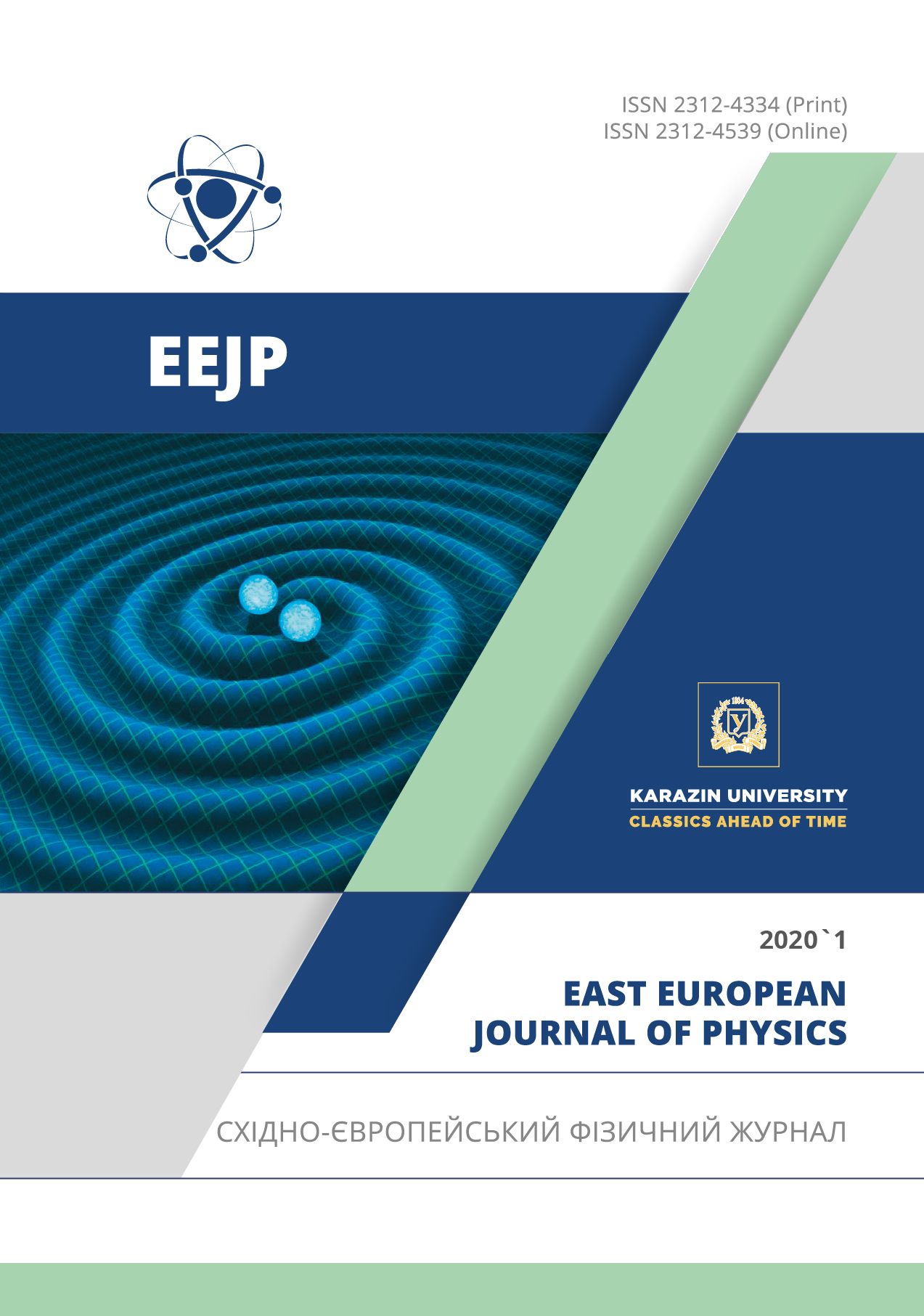Liquidus Surface and Spinodal of Fe-B-C Alloys
Abstract
In this work the study is performed for the specimens of Fe-B-C alloys with boron content of 0.005–7.0 wt. % and carbon content of 0.4–6.67 wt. %, the rest is iron. According to the findings of microstructure analysis, XRD and differential thermal analyses, the primary phases and the temperatures of their formation are determined. Depending on boron content (in the range of 1.5–8.80 wt. %) and carbon content (0.5–6.67 wt. %) in the Fe-B-C alloys, the primary phases in the process of crystallization are γ-Fe, boron cementite Fe3(CB) and boride Fe2В. The outcomes of the experiment carried out in this work determine the phase composition and phase transformations occurring in the alloys and the liquidus surface is constructed. The findings show that the liquidus temperature for Fe-B-C system alloys is low compared to binary Fe-B and Fe-C alloys. At the liquidus surface of the Fe-B-C alloys, there is a point at boron content of 2.9 wt. % and carbon content of 1.3 wt. % with the lowest temperature of 1375 K and it is the point of intersection of monovariant eutectics. This fact is in a good agreement with the results of other authors. The microstructure of alloys located at the curves of monovariant eutectics is represented by the γ–Fe+Fe2B and γ–Fe+Fe3(CB) eutectics and the primary crystals of Fe2B iron boride in the shell of Fe3(BC) boron cementite. In this paper it is shown experimentally the existence of a quasi-binary section and the coordinates of the peritectic point are fixed: the boron content is 5.0 wt. %, carbon content is 3.0 wt. % and the temperature is 1515 K. The free energy of the Fe-B-C melt is calculated for the first time by the quasi-chemical method and the surface of thermodynamic stability of the Fe-B-C melt is plotted, depending on temperature and boron and carbon content in the alloy. The results obtained in the paper show that in order to obtain a homogeneous Fe-B-C melt, which does not contain any microheterogeneous structure in the form of short-order microregions, it is necessary to perform the overheating more than to 180 K for the region where the primary phase is iron, and no less than to 200 K for the regions with boron cementite and boride.
Downloads
References
Fu Han-guang, Nonferrous Metals. 9, 113 (2005), http://en.cnki.com.cn/Article_en/CJFDTotal-ZZZZ200509006.htm.
Zhao Guorong, Li Zhenhua, Liu Meihong, He Zhengyuan, Hot Working Technology. 15, 113 (2011), http://en.cnki.com.cn/Article_en/CJFDTotal-SJGY201115001.htm.
Song Xu, Fu Han, Yang Jun, Transactions of Materials and Heat Treatment. 10, 164 (2008), http://en.cnki.com.cn/Article_en/CJFDTOTAL-JSCL200801010.htm.
P. Sang, H. Fu, Y. Qu, C. Wang and Y. Lei, Materials Science & Engineering Technology. 46(9), 962 (2015), https://doi.org/10.1002/mawe.201500397.
Ayako Sudo, Tsuyoshi Nishi, Noriko Shirasu, Masahide Takano and Masaki Kurata, Journal of Nuclear Science and Technology. 52(10), 1308 (2015), https://doi.org/10.1080/00223131.2015.1016465.
Xiangyi Ren, Hanguang Fu, Jiandong Xing, Yongwei Yang and Shuli Tang, Journal of Materials Research. 32(16), 3078 (2017), https://doi.org/10.1557/jmr.2017.304.
Zhi Fu Huang, Jian Dong Xing, Sheng Qiang Ma, Yi Min Gao, Ming Zheng and Li Qiu Sun, Key Engineering Materials. 732, 59 (2017), https://doi.org/10.4028/www.scientific.net/KEM.732.59.
I.M. Spiridonova, S.B. Pilyaeva, Е.В. Syxovaya, Е.В. Zinkovskiy, Vіsnyk Dnіpropetrovskogo nacіonalnogo unіversytetu. Serіja Fіzyka. Radіoelektronіka, 8, 32-44 (2002). (in Ukrainian)
N.Yu. Filonenko, S.B. Pilyaeva, Journal of V.N. Karazin Kharkiv National University, series "Physics", 21(1135), 49–51 (2014), https://periodicals.karazin.ua/physics/article/view/7817/7290. (in Ukrainian)
Eberhard Schṻrmann, Clausthal, Shao-Xiong Li, Jilin Bor 37. Jahrgang,121-129 (1985).
S.V. Tverdokhlebova, Vіsnyk Dnіpropetrovskogo nacіonalnogo unіversytetu. Serіja Fіzyka. Radіoelektronіka, 14(12/1), 100 104 (2007), http://www.vdnu.narod.ru/v14/pdf/s26_14.pdf. (in Ukrainian)
Takafumi Hibino, Teruo Bitoh, Journal of Alloys and Compounds. 707(15), 82 (2017), https://doi.org/10.1016/j.jallcom.2016.12.060.
E.D. Soldatova, Journal of Molecular Liquids. 127(1-3), 99 (2006), https://doi.org/10.1016/j.molliq.2006.03.027.
N.Yu. Filonenko, East. Eur. J. Phys. 5(1), 55-60 (2018), https://doi.org/10.26565/2312-4334-2018-1-06.
J.W. Gibbs, Термодинамика. Статистическая механика [Thermodynamic. Statistical Mechanics], (Moscow, Nauka, 1982), pp. 584. (in Russian)
Tian Wei He, Ye Hua Jiang, Rong Zhou, Jing Feng, RSC Advances. 51, 45250 (2016), https://doi.org/10.1039/C6RA05969D.
D. Terentyev, K. Heinola, A. Bakaev and E. E. Zhurkin, Scripta Materialia. 86, 9 (2014), https://doi.org/10.1016/j.scriptamat.2014.04.003.
T. Ohnuma, N. Soneda and M. Iwasawa, Acta Materialia. 57, 5947 (2009), https://doi.org/10.1016/j.actamat.2009.08.020.
N.Yu. Filonenko, O.S. Baskevych and V.V. Soboliev, Journal Scientific Bulletin of National Mining University. 4, 74 (2012), http://nv.nmu.org.ua/index.php/en/component/jdownloads/finish/34-04/528-2012-4-filonenko/0.
O.Yu. Bereza, N.Yu. Filonenko, O.S. Baskevich, Physics and Chemistry of Solid State, 13(3), 968-973 (2012), http://page.if.ua/uploads/pcss/vol13/1304-21.pdf. (in Ukrainian)
Authors who publish with this journal agree to the following terms:
- Authors retain copyright and grant the journal right of first publication with the work simultaneously licensed under a Creative Commons Attribution License that allows others to share the work with an acknowledgment of the work's authorship and initial publication in this journal.
- Authors are able to enter into separate, additional contractual arrangements for the non-exclusive distribution of the journal's published version of the work (e.g., post it to an institutional repository or publish it in a book), with an acknowledgment of its initial publication in this journal.
- Authors are permitted and encouraged to post their work online (e.g., in institutional repositories or on their website) prior to and during the submission process, as it can lead to productive exchanges, as well as earlier and greater citation of published work (See The Effect of Open Access).








